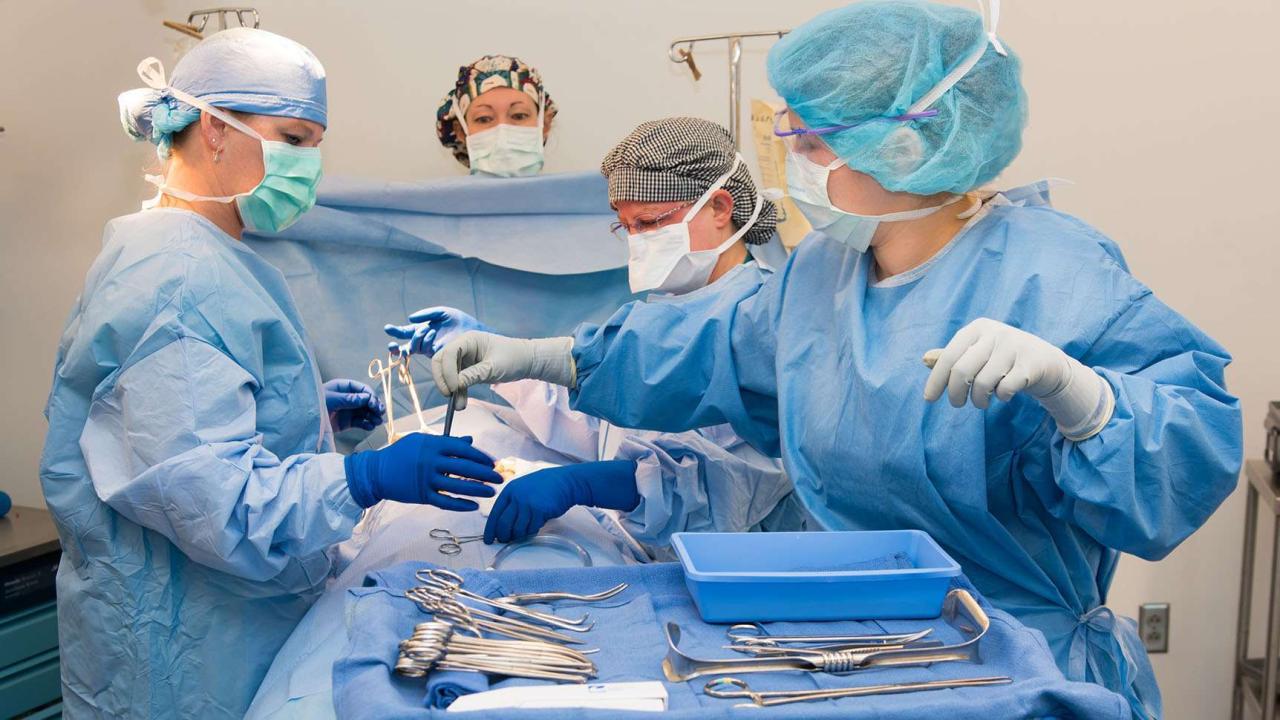Surgical tech programs near me? Finding the right program can feel overwhelming, but it’s a journey worth taking. Whether you’re switching careers, looking for local options, or have specific educational preferences, understanding your options is key. This guide helps you navigate the process, from finding accredited programs to weighing costs and career prospects.
We’ll explore different program types, help you identify reputable schools using online tools, and provide insights into curriculum, job opportunities, and financing. You’ll learn how to evaluate programs based on factors like accreditation, job placement rates, and the skills they teach. Ultimately, we aim to equip you with the knowledge to make an informed decision about your future in surgical technology.
Understanding the Search “Surgical Tech Programs Near Me”
The search query “surgical tech programs near me” reveals a user’s immediate need to find relevant educational opportunities within their geographical area. This search reflects a combination of factors influencing the user’s decision-making process. These factors include career aspirations, proximity to educational institutions, and personal preferences regarding program structure and delivery method.
Motivations Behind the Search
Several motivations drive this search. Individuals may be seeking a career change, looking for a shorter, more focused program compared to a four-year degree, or prioritizing a convenient location due to family or work commitments. Some might prefer specific program features like hands-on training or online learning options. The search also suggests a desire for immediate action and potentially a time-sensitive decision.
User Demographics
The typical user performing this search could range from recent high school graduates exploring career options to working professionals seeking a career transition. They may include individuals from diverse educational backgrounds, and their age range could span from late teens to mid-career professionals in their 40s or 50s. Geographical location is a key determinant, as the search is location-specific.
Types of Surgical Technology Programs
The search results might encompass various program types, including associate degree programs, certificate programs, diploma programs, and even online or hybrid programs. Each program type varies in length, intensity, and curriculum focus. Some might emphasize specific surgical specialties, while others offer a broader surgical technology foundation.
Locating Surgical Tech Programs: Surgical Tech Programs Near Me
Finding suitable surgical technology programs requires a strategic approach utilizing various online resources. A systematic search using specific s and filters can significantly streamline the process.
Strategies for Identifying Programs
Begin by using search engines like Google, Bing, or DuckDuckGo, incorporating your location (“surgical tech programs near [your city/state]”). Refine your search with additional s like “associate degree,” “certificate program,” or “online program” to narrow your results. Explore professional organizations’ websites and online directories specializing in healthcare education.
Online Resources for Program Listings
Websites such as the American College of Surgeons (ACS), the Association of Surgical Technologists (AST), and various state-level healthcare boards often maintain listings of accredited surgical technology programs. Online directories like those provided by the U.S. Department of Education can also prove useful. Many community colleges and vocational schools will have dedicated program pages on their websites.
So you’re looking into surgical tech programs near me? That’s awesome! Finding the right program is a big decision, but you’ll want a break sometimes. Check out the confirmed line-ups for today’s big match: Confirmed line-ups | Spurs vs Newcastle , then get back to researching those surgical tech programs. Good luck with your search and enjoy the game!
Criteria for Evaluating Programs

Evaluating programs requires a structured approach, considering factors like accreditation, curriculum, faculty expertise, job placement rates, and cost. A balanced assessment of these factors ensures a suitable program choice.
| Criterion | Description | Importance | How to Assess |
|---|---|---|---|
| Accreditation | Verification of program quality and standards. | High | Check for accreditation by recognized bodies (e.g., CAAHEP). |
| Curriculum | Course content and practical training components. | High | Review program Artikels and course descriptions. |
| Job Placement Rate | Percentage of graduates securing employment in the field. | High | Check program’s published data or contact alumni. |
| Faculty Expertise | Experience and qualifications of instructors. | Medium | Review faculty profiles on program websites. |
Program Curriculum and Requirements

Surgical technology programs typically offer a comprehensive curriculum blending theoretical knowledge with extensive hands-on practical training. Admission requirements vary but often include prerequisite courses and a formal application process.
Curriculum Comparison
Curricula vary slightly across institutions, but common themes include anatomy and physiology, surgical procedures, sterilization techniques, medical terminology, and surgical assisting skills. Some programs may specialize in areas like cardiovascular surgery or orthopedics.
Admission Requirements
Typical admission requirements include a high school diploma or GED, prerequisite courses in science (biology, chemistry), and possibly a minimum GPA. The application process generally involves submitting transcripts, letters of recommendation, and potentially completing an entrance exam.
Key Skills and Knowledge
- Sterile field techniques
- Surgical instrument identification and use
- Anatomy and physiology
- Medical terminology
- Surgical procedures and assisting techniques
- Patient care and safety
- Infection control protocols
Career Outlook and Job Opportunities
The job market for surgical technologists shows consistent demand, although variations exist across geographical regions. Job opportunities are prevalent in hospitals, surgical centers, and other healthcare settings.
Job Market Analysis
Major metropolitan areas and regions with a high concentration of hospitals and medical facilities tend to offer more job opportunities. However, even smaller communities often have a need for surgical technologists in their local hospitals or clinics. Demand is expected to remain steady due to an aging population and advancements in surgical procedures.
Looking for surgical tech programs near me? Finding the right school is a big decision, kind of like a football manager choosing a striker. Check out how Burnley’s manager, Vincent Kompany, is handling their striker situation after Ashley Barnes left – read about it here: Thorup outlines City striker plans after Ashley Barnes exit. Just like choosing a program, finding the right player requires careful planning! So, research those surgical tech programs thoroughly before you commit.
Typical Job Roles and Responsibilities, Surgical tech programs near me

Surgical technologists work as part of the surgical team, preparing the operating room, assisting surgeons during procedures, and maintaining sterile conditions. Responsibilities encompass a wide range of tasks, from setting up equipment to handling surgical instruments and assisting with wound closure.
| Region | Average Salary (USD) | Job Growth Projection (Next 10 years) | Data Source |
|---|---|---|---|
| Example Region A (e.g., California) | $55,000 – $70,000 | 10-15% | Bureau of Labor Statistics (BLS) estimates |
| Example Region B (e.g., Midwest) | $48,000 – $60,000 | 8-12% | Bureau of Labor Statistics (BLS) estimates |
| Example Region C (e.g., South) | $45,000 – $55,000 | 7-10% | Bureau of Labor Statistics (BLS) estimates |
Cost and Financing Options
The cost of surgical technology programs varies depending on the institution, program length, and location. Tuition fees, books, supplies, and living expenses contribute to the overall cost. Various financing options can help mitigate these expenses.
Looking for surgical tech programs near me? Finding the right school is a big decision! Take a quick break and check out this exciting game – Tune In: Virginia Tech vs. Minnesota – before you dive back into researching those programs. Remember to compare program curriculums and accreditation when making your choice for surgical tech training.
Program Costs
Tuition fees can range from several thousand dollars to over $20,000 for a complete program. Additional expenses include books, lab fees, uniforms, and potentially transportation and living costs if attending a program away from home. It’s crucial to obtain detailed cost breakdowns from prospective institutions.
Financial Aid Opportunities
Financial aid options include federal student loans, grants, scholarships, and institutional aid. Many colleges and universities offer financial aid packages to students based on financial need and academic merit. Exploring scholarships specifically for healthcare professions can also yield significant assistance.
Calculating Total Program Cost
Calculating the total cost requires adding tuition, fees, books, supplies, and estimated living expenses (housing, food, transportation) for the program’s duration. A realistic budget should account for all potential expenses to avoid financial strain during the program.
Program Accreditation and Licensing
Accreditation and licensure are essential for ensuring quality education and professional recognition in the field of surgical technology. Accredited programs meet established standards, while licensure grants legal authorization to practice.
Importance of Accreditation
Accreditation signifies that a program meets specific educational standards and quality benchmarks set by recognized accrediting bodies. It assures employers and potential students that the program provides a rigorous and relevant education.
Certification and Licensure
Certification and licensure requirements vary by state. Certification often involves passing a national exam administered by organizations like the National Board of Surgical Technology and Surgical Assisting (NBSTSA). State licensure may involve additional requirements, such as background checks and continuing education.
Accrediting Bodies
- Commission on Accreditation of Allied Health Education Programs (CAAHEP)
- Accreditation Review Council on Education in Surgical Technology and Surgical Assisting (ARC/STSA)
Illustrative Examples of Program Structures
Surgical technology programs typically combine classroom instruction with extensive clinical rotations and hands-on training in a hospital or surgical center setting. Program formats vary, offering flexibility to accommodate diverse learning styles and schedules.
Typical Program Structure
A typical day might involve morning lectures on anatomy, physiology, or surgical techniques, followed by afternoon laboratory sessions practicing sterile techniques or instrument handling. Clinical rotations provide real-world experience in operating rooms, assisting surgeons with various procedures under the supervision of experienced surgical technologists. Students gain practical skills, apply theoretical knowledge, and observe the dynamics of a surgical team in action.
Program Formats
Programs are offered in various formats, including full-time, part-time, and online options. Full-time programs are typically more intensive and shorter, while part-time programs allow students to balance their studies with work or family commitments. Online programs provide flexibility but may require more self-discipline and independent learning.
Comparing Program Lengths and Schedules
Program lengths vary, ranging from a few months for certificate programs to two years for associate degree programs. Carefully comparing program lengths and schedules allows individuals to choose a program that aligns with their personal circumstances and career goals. Factors like time commitment, financial resources, and career aspirations should guide this decision.
Conclusion
Launching a career as a surgical technologist requires careful planning and research. This guide provided a roadmap to help you locate and evaluate surgical tech programs in your area. Remember to consider program accreditation, curriculum, career prospects, and financing options when making your decision. With thorough preparation and the right program, you’ll be well-equipped for a rewarding career in this dynamic field.
Good luck on your journey!
FAQ Compilation
What’s the difference between a certificate and an associate’s degree in surgical technology?
Certificate programs are shorter and often focus on practical skills. Associate’s degrees offer a broader education, including more general education courses.
How long does it take to complete a surgical tech program?
Program length varies, typically ranging from 9 months to 2 years, depending on the program type and intensity (full-time vs. part-time).
Are there online surgical tech programs?
While many programs require in-person clinical rotations, some offer online components for coursework. Check individual program details.
What is the average starting salary for a surgical technologist?
Starting salaries vary by location and experience, but generally range from $45,000 to $60,000 annually.
